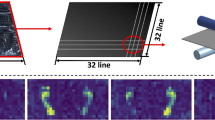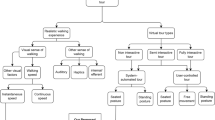Abstract
Mechanical repositioning is a locomotion technique that uses a mechanical device (i.e. locomotion interface), such as treadmills and pedaling devices, to cancel the displacement of a user for walking on the spot. This technique is especially useful for virtual reality (VR) systems that use large-scale projective displays for visualization. In this paper, we present a machine learning approach for developing a mechanical repositioning technique based on a 1-D treadmill for interacting with a unique new large-scale projective display, named as the Wide-Field Immersive Stereoscopic Environment (WISE). We also assessed the usability of the proposed approach through a novel user study that asked participants to pursue a rolling ball at variable speed in a virtual scene. Our results show that participants differ in their ability to carry out the task. We provide an explanation for the variable performance of the participants based on the locomotion technique.
Access this chapter
Tax calculation will be finalised at checkout
Purchases are for personal use only
Similar content being viewed by others
References
Robinett, W., Holloway, R.: Implementation of flying, scaling and grabbing in virtual worlds. In: Proceedings of Symposium on I3D 1992, pp. 189–192. ACM (1992)
Laviola JR, J.J., Feliz, D.A., Keefe, D.F. Zeleznik, R.C.: Hands-free multi-scale navigation in virtual environments. In: Proceedings of Symposium on I3D 2001, pp. 9–15. ACM (2001)
Slater, M., Steed, A., Usoh, M.: The virtual treadmill: a naturalistic metaphor for navigation in immersive virtual environments. In: Göbel, M. (ed.) Virtual Environments 1995. Eurographics. Springer, Vienna (1995). https://doi.org/10.1007/978-3-7091-9433-1_12
Templeman, J., Denbrook, P., Sibert, L.: Virtual locomotion: walking in place through virtual environments. Presence 8(6), 598–617 (1999)
Yan, L., Allison, R.S., Rushton, S.K.: New simple virtual walking method-walking on the spot. In: Proceedings of 8th Annual IPT Symposium (2004)
Wendt, J.D., Whitton, M.C., Brooks, F.P.: GUD WIP: gait-understanding-driven walking-in-place. In: Proceedings of IEEE VR, pp. 51–58 (2010)
Razzaque, S., Kohn, Z., Whitton, M.C.: Redirected walking (short paper presentation). In: Eurographics (2001)
Nilsson, N.C., Serafin, S., Laursen, M.H., Pedersen, K.S., Sikstrom, E., Nordahl, R.: Tapping-In-Place: increasing the naturalness of immersive walking-in-place locomotion through novel gestural input. In: IEEE Symposium on 3D UI, pp. 31–38 (2013)
Hollerbach, J.M.: Locomotion interfaces. In: Handbook of Virtual Environments: Design, Implementation, and Applications, pp. 239–254. Lawrence Erlbaum Assoc., Inc. (2002)
Souman, J.L., Robuffo Giordano, P., Schwaiger, M., Frissen, I., Thummel, T., Ulbrich, H., De Luca, A., Bulthoff, H.H., Ernst, M.O.: Cyberwalk: Enabling unconstrained omnidirectional walking through virtual environments. ACM Trans. Appl. Percept. 8, 4 (2001)
Iwata, H.: Walking about virtual environments on an infinite floor. In: Proceedings of IEEE VR, pp. 286–293 (1999)
Iwata, H., Yano, H., Nakaizumi, F.: Gait master: a versatile locomotion interface for uneven virtual terrain. In: Proceedings of IEEE VR, pp. 131–137 (2001)
Allison, R.S., Harris, L.R., Jenkin, M., Pintilie G., Redlick, F., Zikovitz, D.C.: First steps with a rideable computer. In: Proceedings of IEEE VR, pp. 169–175 (2000)
Medina, E., Fruland, R., Weghorst, S.: Virtusphere: walking in a human size VR “Hamster Ball”. Proc. Hum. Fact. Ergon. Soc. Annu. Meet. 52(27), 2102–2106 (2008)
Park, H.J., Lee, H.J., Kang, T.H., Moon, J.I.: Study on automatic speed adaptation treadmills. In: 15th ICCAS, pp. 1898–1900 (2015)
von Zitzewitz, J., Bernhardt, M., Riener, R.: A novel method for automatic treadmill speed adaptation. IEEE Trans. Neural Syst. Rehabil. Eng. 15(3), 401–409 (2007)
Souman, J.L., Giordano, P.R., Frissen, I., De Luca, A., Ernst, M.O.: Making virtual walking real: Perceptual evaluation of a new treadmill control algorithm. ACM Trans. Appl. Percept. 7, 2 (2010)
Su, S.W., Wang, L., Celler, B.G., Savkin, A.V.: Heart rate control during treadmill exercise. In: 27th Annual International Conference in EMBS, pp. 2471–2474 (2005)
Yoon, J., Park, H.S., Damiano, D.L.: A novel walking speed estimation scheme and its application to treadmill control for gait rehabilitation. J. Neuroeng. Rehab. 9, 62 (2012)
Park, J., Patel, A., Curtis, D., Teller, S., Ledlie, J.: Online pose classification and walking speed estimation using handheld devices. In: Proceedings of ACM Conference UbiComp, pp. 113–122 (2012)
Rose, J., Gamble, J.G.: Human Walking. Williams & Wilkins, Baltimore (1994)
Maneewongvatana, S., Mount, D.M.: On the efficiency of nearest neighbor searching with data clustered in lower dimensions. In: Proceedings of ICCS 2001, pp. 842–851 (2001)
Sokolova, M., Lapalme, G.: A systematic analysis of performance measures for classification tasks. Inf. Process. Manage. 45(4), 427–437 (2009)
Vijayakar, A., Hollerbach, J.M.: A proportional control strategy for realistic turning on linear treadmills. In: Proceedings of 10th Symposium on HAPTICS, pp. 231–238 (2002)
Author information
Authors and Affiliations
Corresponding author
Editor information
Editors and Affiliations
Rights and permissions
Copyright information
© 2018 Springer International Publishing AG, part of Springer Nature
About this paper
Cite this paper
Zhao, J., Allison, R.S. (2018). Learning Gait Parameters for Locomotion in Virtual Reality Systems. In: Wannous, H., Pala, P., Daoudi, M., Flórez-Revuelta, F. (eds) Understanding Human Activities Through 3D Sensors. UHA3DS 2016. Lecture Notes in Computer Science(), vol 10188. Springer, Cham. https://doi.org/10.1007/978-3-319-91863-1_5
Download citation
DOI: https://doi.org/10.1007/978-3-319-91863-1_5
Published:
Publisher Name: Springer, Cham
Print ISBN: 978-3-319-91862-4
Online ISBN: 978-3-319-91863-1
eBook Packages: Computer ScienceComputer Science (R0)




